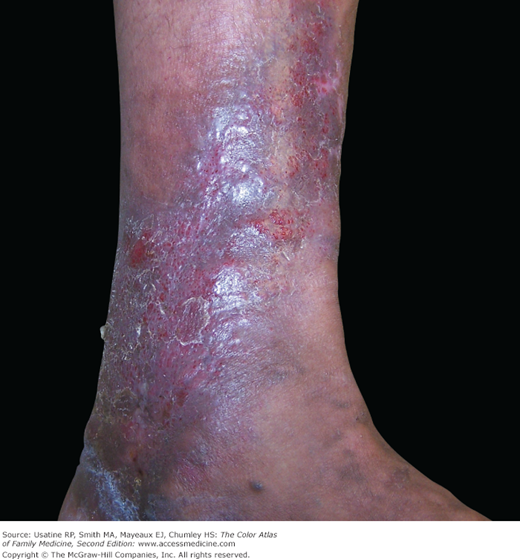Patient Story
A 45-year-old woman presents to her physician’s office with complaints of heaviness and fatigue in her legs (Figure 52-1). She does not experience the symptoms in the morning but they become more noticeable as the day progresses and with prolonged standing. When she stands for many hours, she develops swelling in both of her legs. The symptoms are concentrated over her medial calf where she has prominent tortuous veins. She first noted the veins approximately 20 years ago when she was pregnant. Initially, they did not cause her any discomfort but have progressively enlarged now and over the past 10 years have become increasingly painful. She recalls that her mother had similar veins in her legs.
Introduction
Venous insufficiency, or improperly functioning valves in the venous system, can lead to variety of symptoms, including, but not limited to, heaviness and/or swelling in the legs with prolonged standing, leg fatigue or aching, bleeding from leg varices, skin changes, and ulcerations. The prevalence is higher in industrialized nations and ranges from 15% to 30% of the U.S. population.
Epidemiology
- Varies by definition and region, but generally venous insufficiency affects 27% of the population.1
- Prevalence estimates vary by some reports, indicating a prevalence of 10.4% to 23% in men and 29.5% to 39% in women.2,3
- More frequent in women as compared to men.
- Symptomatic in more than two-thirds of those affected.
- Varicose veins are notable only in half of patients with venous insufficiency.4
Etiology and Pathophysiology
- Most frequently it is a result of valvular dysfunction.
- Valvular dysfunction may be primary or secondary (result of trauma, deep venous thrombosis [DVT], or May-Thurner syndrome).
- It may affect deep system (i.e., femoral veins), superficial system (i.e., saphenous vein), or both.
- The superficial system is involved in 88% of cases either alone or in conjunction with the deep system.
- Dysfunction leads to loss of compartmentalization of veins, leading to distention and increased pressure (Figures 52-1 and 52-2).
- Increased pressure in veins is transmitted to microvasculature leading to basement membrane thickening, increased capillary elongation, and visual skin changes (Figures 52-3 and 52-4).
Stay updated, free articles. Join our Telegram channel

Full access? Get Clinical Tree






